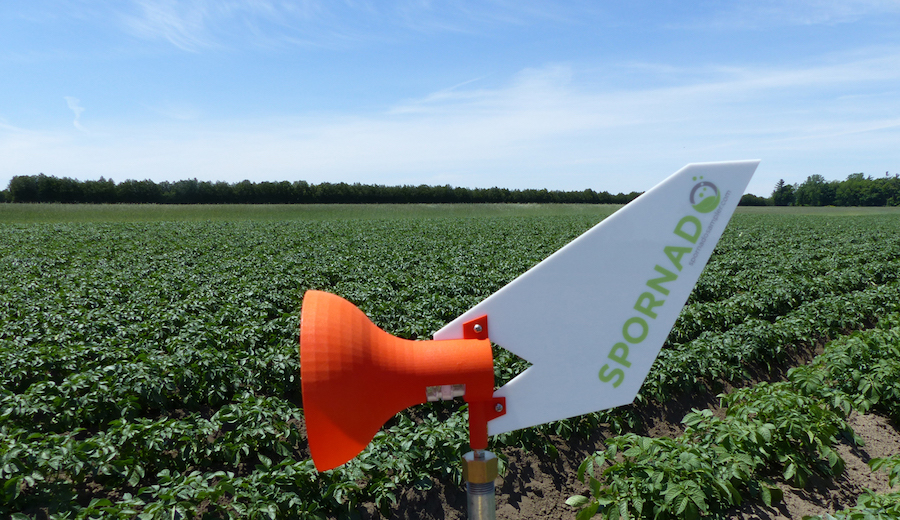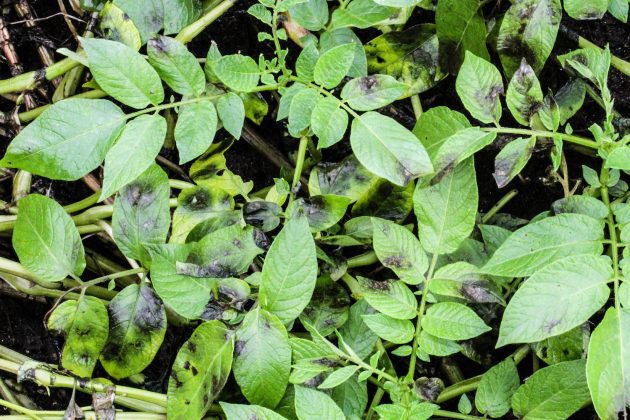
Crop Watch
News
Diseases
Alberta spore traps catch late blight spores
June 19, 2020 By Stephanie Gordon
 The latest model of the spore traps installed across fields in Ontario to help detect spores of late blight. Photo courtesy of Eugenia Banks.
The latest model of the spore traps installed across fields in Ontario to help detect spores of late blight. Photo courtesy of Eugenia Banks. On June 18 a crop consultant in Alberta told Eugenia Banks, Ontario potato specialist, that spore traps in the province had caught late blight spores.
Ontario is going through a wave of hot and dry weather, and out west in Alberta, it’s the opposite with cooler, wet weather.
The fields are healthy but the detection of late blight spores is of concern, according to Banks.
Alberta had almost been late blight free until 2010 when late blight was discovered in many Alberta potato fields. In 2014 in response to the discovery, the Potato Growers of Alberta (PGA) supported a spore-trapping project.
The study was headed up by Melanie Kalischuk and students at Lethbridge College, with assistance from Michael Harding and Ron Howard with Alberta Agriculture and Rural Development at Brooks, and Lawrence Kawchuk at Agriculture and Agri-Food Canada’s Lethbridge Research Centre. Funding for the study was provided by PGA, Alberta Crop Industry Development Fund, Cavendish Farms, Lamb Weston and Crop Production Services. The PGA also supported the study by disseminating spore-trap counts to growers in real-time.
The traps were set up at the edges of farmers’ fields, or just west of fields, because late blight spores tend to travel east to west. The researchers found that once spore levels spiked in the traps, they had about a 10- to 16-day window before late blight appeared in nearby fields.
Back in 2014, Terence Hochstein, executive director of the PGA, said the study did exactly what they’d hoped it would: it provided growers with an early warning about the advancing spread of Phytophthora infestans (the pathogen that causes late blight) so they could tighten up their existing spray programs and stay ahead of the pathogen.
But Kalischuk said at the time that the benefit of the study goes beyond immediate payoffs for growers. “Another important component of this study is to identify hot-spots for infection and then to educate people in these areas on practices that can help eliminate late blight,” she says. “A number of years ago, Alberta potatoes had an economic advantage because late blight was rare in the province. With this project we are helping to bring back the Alberta advantage.”
Spore trapping continues in Ontario
In Ontario, Eugenia Banks lead a two-year Ontario Potato Board project evaluating one type of spore trapping technology in order to help growers improve late blight management with good results. The year 2020 marks the fourth year spore traps will be set up in potato fields across Ontario to help detect spores of late blight. The traps are placed in Shelburne, Alliston, and Simcoe-Delhi areas.
Banks says two late blight spore traps are up and running in the Alliston area, and two traps will be installed in the Shelburne-Melancthon area on June 19.
Spore traps are low-technology devices that sit in a field and collect disease spores from the air and water. The collected filters are sent to A&L Laboratories for bi-weekly PCR analysis to assess disease risk. The results are shared with growers and early detection of late blight potential helps alert growers to add late blight fungicide into their mix.

The initial symptoms of late blight. Photo courtesy of Andy Robinson, North Dakota State University.
Banks says in 2019, spore traps caught late blight sporangia – a sporangium is an enclosure in which spores are formed – during prolonged dry periods.
“There were areas in Blair County, New York, with many infested fields, and the sporangia may have blown in from there. Sporangia can be carried long distances by wind,” Banks explains.
To stay ahead of late blight, Eugenia Banks shares early summer, mid-summer, and late summer practices to protect growers against late blight in their potato fields. “Remember, an ounce of prevention is worth a pound of cure,” Banks says.
Print this page